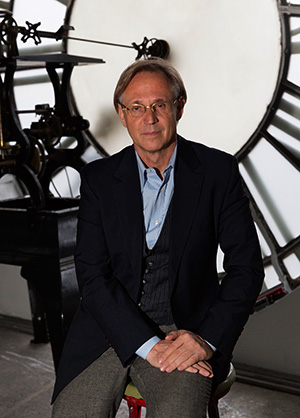Marek Bartelik: From Civil Engineer to Art Critic
POSTED ON: January 26, 2015

Marek Bartelik, January 2015. Photos by João Enxuto
Marek Bartelik, art historian, art critic, poet, former civil engineer, international man of letters and 20-year member of The Cooper Union faculty of humanities and social sciences returns this spring after a three-year teaching hiatus. He has been busy as President of the International Association of Art Critics (known as AICA after the French Association Internationale des Critiques d'Art), a position he was recently re-elected to hold until 2017. After seeing through administrative changes during his first term he says he can relax the day-to-day running of the 65-year-old organization and return to teaching. We sat down with him at his tastefully decorated apartment on East 6th street, around the corner from 41 Cooper Square, to talk about his work with AICA, his transition from engineer to art critic and the changing role of the professional art critic.
You were born and raised in Poland, a member of the Eastern Bloc during the height of the Cold War. How did you end up in the West?
I left Poland in the summer of 1981 as the old State Socialist system was collapsing, causing serious economic problems and the massive social unrest that went with them. But, as dissatisfied with the political reality in Poland of that time as I was, I left mainly because—to put it simply—I wanted to start a new chapter in my life, away from what looked to me like a routine existence. I left Poland a year before graduating from the Department of Civil Engineering at the Agro-Technical Academy in Olsztyn, a large provincial town in the northeast of the country. I went to France and soon enrolled at the École des Beaux-Arts. I never finished those studies, but it did not matter, because the important thing was that I did become actively engaged in living a creative life back then— not as an artist but as a writer on art.
 Tell us about your transition from engineering to art.
Tell us about your transition from engineering to art.
It was not linear. As I already mentioned, I studied civil engineering in Poland. Then, I studied art in Paris. When I moved to New York in 1984, I had to be practical again, so I studied to get my Masters in civil engineering at Columbia University. After finishing that program I worked for about five years for a big engineering company on Wall Street. The company had a monopoly on renovating major bridges in New York. I am particularly proud of designing a restraining frame for one of the cables in the Williamsburg Bridge. It might still be there. But I don’t think I was a good engineer, because I was thinking about art too much. Although a great profession, engineering was not for me. After I quit my job as a civil engineer I went back to school to get my Ph.D. in art history from the Graduate Center of the City University of New York. So I think I can say that the shift from civil engineer to art historian, and all the hardship it involved, paid off. However, today I look back with a little bit of nostalgia for those years spent on the bridges of New York.
How did you end up teaching at The Cooper Union?
In the mid-1990s I was asked to find a contributor to a book on the sculptor Ursula von Rydingsvard. Someone suggested Dore Ashton [a member of the faculty of HSS - ed.] We collaborated on that book and through Dore I met John Harrington, then dean of the department of humanities and social sciences. After hearing of my double degree in art history and engineering he offered me an opportunity to teach a class on Art and Science. Gradually I switched to teaching Contemporary Art and Russian Art. I taught here as an adjunct for 16 years. I left about three years ago mainly because I became president of AICA International. It was a great honor, but also a great responsibility, which involves extensive travelling around the world.
What exactly is the International Association of Art Critics?
AICA was established in the aftermath of the Second World War with a mission to promote independent art criticism and art around the world. It is an NGO affiliated with UNESCO, with 63 national chapters and an Open Section and a membership of about 5000 critics in almost 100 countries on five continents. Originally, the association was very Eurocentric, but there were many critics from the United States as well. Ultimately we have grown to be a truly global organization. Today we have a strong presence in Latin America, and we are growing in Asia and Africa.
How does one become a member?
To be a member, one has to actively practice art criticism and focus on modern and contemporary art. National sections gather and review applications, which then are submitted to the office in Paris. Different sections have different screening processes. For example, in the US emphasis is placed on the requirement that the critic has to be a practicing one, not just an academic. Of course, sometimes those boundaries can be fluid, but basically AICA is an association of art critics, not of art historians or curators. The US section, of which I was President before becoming the President of AICA International, is the largest one, with a membership of about 500 critics. The smallest sections, such as the one in Pakistan, have less than 10 members. A year ago, I reinstated the section in Cuba and now I am now working on having sections in Bangladesh (where I was just a few weeks ago) and India.
What does it mean to become a member?
During the Cold War, AICA played a fundamental role in promoting art criticism and art in the places lacking freedom, such as Eastern Europe and Latin America. But, in fact, we were needed all over the world as it was emerging from the Second World War. Today, the same urgency applies to Africa, the Middle East, and also to Asia, where art criticism is still underdeveloped. Each year we organize an international Congress in a different part of the world. The most recent one took place in South Korea; prior to that there were congresses in Slovakia, Switzerland, and Paraguay. We also organize symposia devoted to contemporary art and criticism; for example in 2013 there was one on art and gender in Colombo, Sri Lanka. We are also very active in defending freedom of speech for writers and artists. During my Presidency, we have redesigned our website to serve as a forum for critics to voice their opinions and interact with each other. The work is not finished; we need to attract more young critics to our association and stay “attuned” to current interests.
What's the current state of art criticism?
It’s clear to me that art critics are not as important as they used to be. Now curators, museum people and collectors set the tone for what is happening in the art world. There is less and less space for critics to publish their texts. And also criticism is becoming less polemical than it should be. But this situation is far from hopeless. Actually, I think by being “powerless” we have come closer to artists and now can have a meaningful exchange of ideas as never before. We can speak about what matters to us all, for example what it means to be creative in a time when creativity is not a priority for many people because we are facing so many other problems. To a certain degree, we can be less “practical”—and more idealistic.
How would you define an art critic?
That’s a big question. I've been writing for Artforum International for over 20 years and still ask myself that. Perhaps an art critic is a person who looks at art with passion and shares his/her thoughts with the readers. It is a person who is willing to discover, to voice his/her personal opinions, while relying not so much on academic knowledge as on broader experience and visual culture. Unlike art historians we can be much more spontaneous. We don't need to focus on the historical significance of art, but more on its impact on us, here and now.
So what's the future for art criticism?
It still largely depends on us, art critics. That's why I think it is important for AICA, as a professional organization, to create more space for people to practice writing in an independent way. We need to facilitate the exchange between critics from different countries around the world and help them find space to publish. As far as the future of art criticism is concerned, let me recall an anecdote, which I heard from a Romanian writer and, then slightly modified: A procession of art critics walks over a cliff. They keep walking, defying gravity. Why do they keep walking? Because they don’t realize that the cliff they walked over stands for the end of art criticism. That’s what I have been doing now for over 20 years.
Is it possible to be a professional art critic anymore?
It is possible. What I say might sound simplistic to some, but I will say it nevertheless: Just experience art with passion. Learn as much as you can (even if in the end you reject what you have learned), and keep your eyes open. Also, write well, so people can enjoy your texts. I hope that my example proves that such an approach can work.




